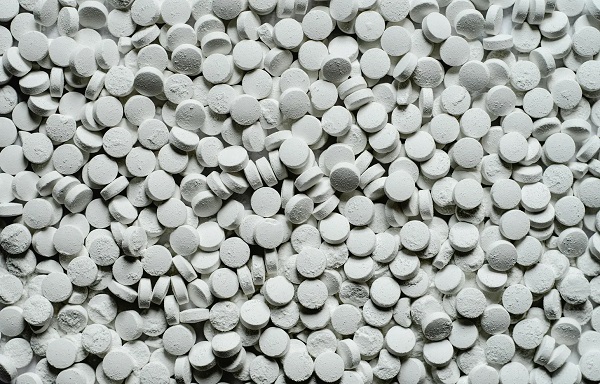Health
Setback for the Transgender movement: Michael Shellenberger on leaked files revealing medical malpractice on children and vulnerable adults

Video interview below background information from EnvironmentalProgress.org
LEAKED FILES FROM WPATH REVEAL WIDESPREAD MEDICAL MALPRACTICE ON CHILDREN AND VULNERABLE ADULTS AT GLOBAL TRANSGENDER HEALTHCARE AUTHORITY
World Professional Association of Transgender Health (WPATH) members demonstrate a lack of consideration for long-term patient outcomes despite being aware of the debilitating and potentially fatal side effects of cross-sex hormones and other treatments
Press Release: JDA Worldwide for Environmental Progress
Newly leaked files from within the leading global transgender healthcare body have revealed that the clinicians who shape how “gender medicine” is regulated and practiced around the world consistently violate medical ethics and informed consent. The files, which were leaked from within the World Professional Association for Transgender Health (WPATH), were published by the US-based think tank Environmental Progress.
WPATH is considered the leading global scientific and medical authority on “gender medicine,” and in recent decades, its Standards of Care have shaped the guidance, policies and practices of governments, medical associations, public health systems and private clinics across the world.
However, the WPATH Files reveal that the organization does not meet the standards of evidence-based medicine, and members frequently discuss improvising treatments as they go along. Members are fully aware that children and adolescents cannot comprehend the lifelong consequences of “gender-affirming care,” and in some cases, due to poor health literacy, neither can their parents.
“The WPATH Files show that what is called ‘gender medicine’ is neither science nor medicine,” said Michael Shellenberger, President and founder of Environmental Progress. “The experiments are not randomized, double-blind, or controlled. It’s not medicine since the first rule is to do no harm. And that requires informed consent.”
The raw files have been published in a report called The WPATH Files: Pseudoscientific surgical and hormonal experiments on children, adolescents, and vulnerable adults, which contains analysis by journalist Mia Hughes that puts the WPATH Files in the context of the best available science on gender distress.
Environmental Progress has made all files available to read at the end of the report. The leaked files include screenshots of posts from WPATH’s internal messaging forum dating from 2021 to 2024 and a video of an internal panel discussion. All names have been redacted other than several WPATH members of public significance, such as Dr. Marci Bowers, an American gynecologist and surgeon who is the President of WPATH, and the Canadian pediatric endocrinologist Dr. Daniel Metzger.
In the WPATH Files, members demonstrate a lack of consideration for long-term patient outcomes despite being aware of the debilitating and potentially fatal side effects of cross-sex hormones and other treatments. Messages in the files show that patients with severe mental health issues, such as schizophrenia and dissociative identity disorder, and other vulnerabilities such as homelessness, are being allowed to consent to hormonal and surgical interventions. Members dismiss concerns about these patients and characterize efforts to protect them as unnecessary “gatekeeping.”
The files provide clear evidence that doctors and therapists are aware they are offering minors life-changing treatments they cannot fully understand. WPATH members know that puberty blockers, hormones, and surgeries will cause infertility and other complications, including cancer and pelvic floor dysfunction. Yet they consider life-altering medical interventions for young patients, including vaginoplasty for a 14-year-old and hormones for a developmentally delayed 13-year-old.
The WPATH Files also show how far medical experiments in gender medicine have gone, with discussions about surgeons performing “nullification” and other extreme body modification procedures to create body types that do not exist in nature.
A growing number of medical and psychiatric professionals say the promotion of pseudoscientific surgical and hormonal experiments is a global medical scandal that compares to major incidents of medical malpractice in history, such as lobotomies and ovariotomies.
“Activist members of WPATH know that the so-called ‘gender-affirming care’ they provide can result in life-long complications and sterility and that their patients do not understand the implications, such as loss of sexual function and the ability to experience orgasm,” Shellenberger said. “These leaked files show overwhelming evidence that the professionals within WPATH know that they are not getting consent from children, adolescents, and vulnerable adults, or their caregivers.”
Environmental Progress has written to every WPATH member named in the files, as well as additional members whose names have been redacted, to confirm their comments and offer a right of reply. Two people responded – one confirmed that the comments attributed to them were correct, and another did not deny their comments but refuted Environmental Progress’ interpretation of them. Mention of Environmental Progress’ outreach to members via email was then later seen in the form of comments on WPATH’s internal messaging forum.
Interview with Michael Shellenberger from Jordan B Peterson Clips
READ: THE WPATH FILES AND REPORT
Health
Dr. Pierre Kory Exposes the Truth About the Texas ‘Measles Death’ Hoax

“She did not die of measles by any stretch of the imagination. In fact, she died of pneumonia. But it gets worse than that…”
Turn on the news today, and you’ll hear about a measles outbreak in Texas. The headline? A 6-year-old girl has “died from measles.” The coverage is nonstop. And the goal is simple: to make you angry and afraid.
But here’s what they’re not telling you.
That little girl should still be alive. She should be at home with her mom, dad, and siblings. But their unconscionable loss, which is being heavily politicized, is not what the mainstream has led us to believe. Her death was the result of medical error. Plain and simple.
And you should be angry.
Join 100K+ Substack readers and 1.6 million 𝕏 users who follow the work of Vigilant Fox.
Subscribe for top-tier news aggregation and exclusive stories you won’t find anywhere else.
When this case first made the news, little was known. But those who know it’s okay to ask questions began asking them.
Was she vaccinated for measles? If so, was the vaccination done recently or while she was ill? What treatment did she receive, if any? Was she infected with the wild type, or was this due to a leaky vaccine? Did she die with measles or from it?
Children’s Health Defense (CHD) stepped up and interviewed the mourning parents to uncover the truth about what really happened to their 6-year-old daughter.
|
Headlines
|
|
Parents of Child Who Died During Texas Measles Outbreak Speak Out |
|
|
|
| This article originally appeared on The Defender and was republished with permission. | |
|
|
The emotional interview reveals the child was not vaccinated for measles. She fell ill, and while the spots faded quickly, her breathing was affected. Her parents became concerned and took her to the emergency room at Covenant Children’s Hospital in Lubbock, Texas.
It was all downhill from there. And before long, their daughter was gone.
Dr. Pierre Kory Shares Disturbing Information
In a display of journalistic integrity, CHD obtained the 6-year-old’s medical records from her parents. Dr. Pierre Kory, a critical care physician, had a chance to analyze the records and shared his thoughts with CHD.
According to Dr. Kory, the child “did not die of measles by any stretch of the imagination. In fact, she died of a pneumonia. But it gets worse than that, because she didn’t really die of pneumonia. She died of a medical error.”
Let that sink in.
Loving parents just lost their young child due to a medical error. But not only that, their story is being twisted and used to spread fear about measles and to push the measles vaccine—two things this family does not appear to agree with.
As it turns out, their four other children came down with measles following their sister’s death. All four were treated with cod liver oil (vitamin A) and budesonide (a steroid). And all four recovered quickly. No vaccination necessary.
Kory calls the case “absolutely enraging.”
“When you admit someone to the hospital for pneumonia, what you need to do is you treat what’s called empirically, meaning you put them on antibiotics that you think will cover the most common organism.”
Covenant Children’s Hospital failed to do this.
“I mean, this is like medicine 101. You put them on two antibiotics to cover all the possibilities. It’s a grievous error, and it’s an error which led to her death.”
Not only did Covenant Children’s Hospital fail to provide the appropriate antibiotics, when they noticed their error, they dragged their feet and delayed another 10 hours.
“By that time, she was already on a ventilator. And approximately 24 hours later, actually less than 24 hours later, she died.”
And she did not pass away peacefully. According to Kory, “she died rather catastrophically.”
“I can only surmise that she died of a catastrophic pulmonary embolism.”
Kory calls the whole thing “disturbing.”
And it is. What happened to this young girl at Covenant Children’s Hospital was indeed disturbing. But the way this tragedy is being portrayed in the media and used inappropriately and inaccurately to cause fear and push the measles vaccine is downright disgusting.
Gone are the days when people seek help from local media to expose injustices. The media machine has one job and it isn’t to help you.
This young girl should still be here. Hugging her parents and giggling with her siblings. Enjoying the start of Spring and looking forward to celebrating Easter.
Instead, the media is exploiting this family’s unimaginable loss to push an agenda, and social media is swirling with nasty criticisms.
We can only hope this poor family receive justice and support as they combat the unwarranted attacks on their character, choices, and way of life.
“Pray. Just pray for us. That’s the best you can do, for now,” the father said.
Subscribe to The Vigilant Fox.
For the full experience, upgrade your subscription.
Addictions
There’s No Such Thing as a “Safer Supply” of Drugs

By Adam Zivo
Sweden, the U.K., and Canada all experimented with providing opioids to addicts. The results were disastrous.
[This article was originally published in City Journal, a public policy magazine and website published by the Manhattan Institute for Policy Research. We encourage our readers to subscribe to them for high-quality analysis on urban issues]
Last August, Denver’s city council passed a proclamation endorsing radical “harm reduction” strategies to address the drug crisis. Among these was “safer supply,” the idea that the government should give drug users their drug of choice, for free. Safer supply is a popular idea among drug-reform activists. But other countries have already tested this experiment and seen disastrous results, including more addiction, crime, and overdose deaths. It would be foolish to follow their example.
The safer-supply movement maintains that drug-related overdoses, infections, and deaths are driven by the unpredictability of the black market, where drugs are inconsistently dosed and often adulterated with other toxic substances. With ultra-potent opioids like fentanyl, even minor dosing errors can prove fatal. Drug contaminants, which dealers use to provide a stronger high at a lower cost, can be just as deadly and potentially disfiguring.
Because of this, harm-reduction activists sometimes argue that governments should provide a free supply of unadulterated, “safe” drugs to get users to abandon the dangerous street supply. Or they say that such drugs should be sold in a controlled manner, like alcohol or cannabis—an endorsement of partial or total drug legalization.
But “safe” is a relative term: the drugs championed by these activists include pharmaceutical-grade fentanyl, hydromorphone (an opioid as potent as heroin), and prescription meth. Though less risky than their illicit alternatives, these drugs are still profoundly dangerous.
The theory behind safer supply is not entirely unreasonable, but in every country that has tried it, implementation has led to increased suffering and addiction. In Europe, only Sweden and the U.K. have tested safer supply, both in the 1960s. The Swedish model gave more than 100 addicts nearly unlimited access through their doctors to prescriptions for morphine and amphetamines, with no expectations of supervised consumption. Recipients mostly sold their free drugs on the black market, often through a network of “satellite patients” (addicts who purchased prescribed drugs). This led to an explosion of addiction and public disorder.
Most doctors quickly abandoned the experiment, and it was shut down after just two years and several high-profile overdose deaths, including that of a 17-year-old girl. Media coverage portrayed safer supply as a generational medical scandal and noted that the British, after experiencing similar problems, also abandoned their experiment.
While the U.S. has never formally adopted a safer-supply policy, it experienced something functionally similar during the OxyContin crisis of the 2000s. At the time, access to the powerful opioid was virtually unrestricted in many parts of North America. Addicts turned to pharmacies for an easy fix and often sold or traded their extra pills for a quick buck. Unscrupulous “pill mills” handed out prescriptions like candy, flooding communities with OxyContin and similar narcotics. The result was a devastating opioid epidemic—one that rages to this day, at a cumulative cost of hundreds of thousands of American lives. Canada was similarly affected.
The OxyContin crisis explains why many experienced addiction experts were aghast when Canada greatly expanded access to safer supply in 2020, following a four-year pilot project. They worried that the mistakes of the recent past were being made all over again, and that the recently vanquished pill mills had returned under the cloak of “harm reduction.”
Subscribe for free to get BTN’s latest news and analysis – or donate to our investigative journalism fund.
Most Canadian safer-supply prescribers dispense large quantities of hydromorphone with little to no supervised consumption. Patients can receive up to 40 eight-milligram pills per day—despite the fact that just two or three are enough to cause an overdose in someone without opioid tolerance. Some prescribers also provide supplementary fentanyl, oxycodone, or stimulants.
Unfortunately, many safer-supply patients sell or trade a significant portion of these drugs—primarily hydromorphone—in order to purchase more potent illicit substances, such as street fentanyl.
The problems with safer supply entered Canada’s consciousness in mid-2023, through an investigative report I wrote for the National Post. I interviewed 14 addiction physicians from across the country, who testified that safer-supply diversion is ubiquitous; that the street price of hydromorphone collapsed by up to 95 percent in communities where safer supply is available; that youth are consuming and becoming addicted to diverted safer-supply drugs; and that organized crime traffics these drugs.
Facing pushback, I interviewed former drug users, who estimated that roughly 80 percent of the safer-supply drugs flowing through their social circles was getting diverted. I documented dozens of examples of safer-supply trafficking online, representing tens of thousands of pills. I spoke with youth who had developed addictions from diverted safer supply and adults who had purchased thousands of such pills.
After months of public queries, the police department of London, Ontario—where safer supply was first piloted—revealed last summer that annual hydromorphone seizures rose over 3,000 percent between 2019 and 2023. The department later held a press conference warning that gangs clearly traffic safer supply. The police departments of two nearby midsize cities also saw their post-2019 hydromorphone seizures increase more than 1,000 percent.
The Canadian government quietly dropped its support for safer supply last year, cutting funding for many of its pilot programs. The province of British Columbia (the nexus of the harm-reduction movement) finally pulled back support last month, after a leaked presentation confirmed that safer-supply drugs are getting sold internationally and that the government is investigating 60 pharmacies for paying kickbacks to safer-supply patients. For now, all safer-supply drugs dispensed within the province must be consumed under supervision.
Harm-reduction activists have insisted that no hard evidence exists of widespread diversion of safer-supply drugs, but this is only because they refuse to study the issue. Most “studies” supporting safer supply are produced by ideologically driven activist-scholars, who tend to interview a small number of program enrollees. These activists also reject attempts to track diversion as “stigmatizing.”
The experiences of Sweden, the United Kingdom, and Canada offer a clear warning: safer supply is a reliably harmful policy. The outcomes speak for themselves—rising addiction, diversion, and little evidence of long-term benefit.
As the debate unfolds in the United States, policymakers would do well to learn from these failures. Americans should not be made to endure the consequences of a policy already discredited abroad simply because progressive leaders choose to ignore the record. The question now is whether we will repeat others’ mistakes—or chart a more responsible course.
Our content is always free –
but if you want to help us commission more high-quality journalism,
consider getting a voluntary paid subscription.
-

 Business2 days ago
Business2 days ago28 energy leaders call for eliminating ALL energy subsidies—even ones they benefit from
-

 2025 Federal Election2 days ago
2025 Federal Election2 days agoCarney’s Cap on Alberta Energy Costing Canada Billions
-

 Business2 days ago
Business2 days agoTrump Tariffs are not going away. Canada needs to adapt or face the consequences
-

 Economy2 days ago
Economy2 days agoSupport For National Pipelines And LNG Projects Gain Momentum, Even In Quebec
-

 Health2 days ago
Health2 days agoDr. Pierre Kory Exposes the Truth About the Texas ‘Measles Death’ Hoax
-

 Business21 hours ago
Business21 hours agoDOGE discovered $330M in Small Business loans awarded to children under 11
-

 Business2 days ago
Business2 days agoWhy a domestic economy upgrade trumps diversification
-

 COVID-1919 hours ago
COVID-1919 hours ago17-year-old died after taking COVID shot, but Ontario judge denies his family’s liability claim













